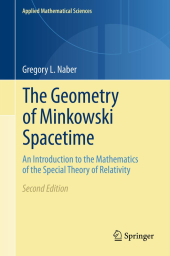 Neuerscheinungen 2014Stand: 2020-02-01 |
Schnellsuche
ISBN/Stichwort/Autor
|
Herderstraße 10
10625 Berlin
Tel.: 030 315 714 16
Fax 030 315 714 14
info@buchspektrum.de |

Gregory L. Naber
The Geometry of Minkowski Spacetime
An Introduction to the Mathematics of the Special Theory of Relativity
2. Aufl. 2014. xvi, 324 S. 235 mm
Verlag/Jahr: SPRINGER, BERLIN; SPRINGER NEW YORK; SPRINGER 2014
ISBN: 1-493-90241-5 (1493902415)
Neue ISBN: 978-1-493-90241-5 (9781493902415)
Preis und Lieferzeit: Bitte klicken
This book offers a presentation of the special theory of relativity that is mathematically rigorous and yet spells out in considerable detail the physical significance of the mathematics. It treats, in addition to the usual menu of topics one is accustomed to finding in introductions to special relativity, a wide variety of results of more contemporary origin. These include Zeeman´s characterization of the causal automorphisms of Minkowski spacetime, the Penrose theorem on the apparent shape of a relativistically moving sphere, a detailed introduction to the theory of spinors, a Petrov-type classification of electromagnetic fields in both tensor and spinor form, a topology for Minkowski spacetime whose homeomorphism group is essentially the Lorentz group, and a careful discussion of Dirac´s famous Scissors Problem and its relation to the notion of a two-valued representation of the Lorentz group. This second edition includes a new chapter on the de Sitter universe which is intended to serve two purposes. The first is to provide a gentle prologue to the steps one must take to move beyond special relativity and adapt to the presence of gravitational fields that cannot be considered negligible. The second is to understand some of the basic features of a model of the empty universe that differs markedly from Minkowski spacetime, but may be recommended by recent astronomical observations suggesting that the expansion of our own universe is accelerating rather than slowing down. The treatment presumes only a knowledge of linear algebra in the first three chapters, a bit of real analysis in the fourth and, in two appendices, some elementary point-set topology.
The first edition of the book received the 1993 CHOICE award for Outstanding Academic Title.
Reviews of first edition:
"... a valuable contribution to the pedagogical literature which will be enjoyed by all who delight in precise mathematics and physics." ( American Mathematical Society, 1993)
"Where many physics texts explain physical phenomena by means of mathematical models, here a rigorous and detailed mathematical development is accompanied by precise physical interpretations." (CHOICE, 1993)
"... his talent in choosing the most significant results and ordering them within the book can´t be denied. The reading of the book is, really, a pleasure." (Dutch Mathematical Society, 1993)
From the reviews of the second edition:
"This text brings sophisticated mathematical structures and tools to play, yet much of the work would be accessible to a motivated undergraduate. ... The author lays out his goal very clearly: ´It is the intention of this monograph to provide an introduction to the special theory of relativity that is mathematically rigorous and yet spells out in considerable detail the physical significance of the mathematics.´ He then proceeds to accomplish this admirably. ... the underlying mathematics is wonderful, worth studying for its own sake." (William J. Satzer, The Mathematical Association of America, May, 2012)
Gregory L. Naber is a Professor in the Department of Mathematics at Drexel University in Philadelphia, PA.


